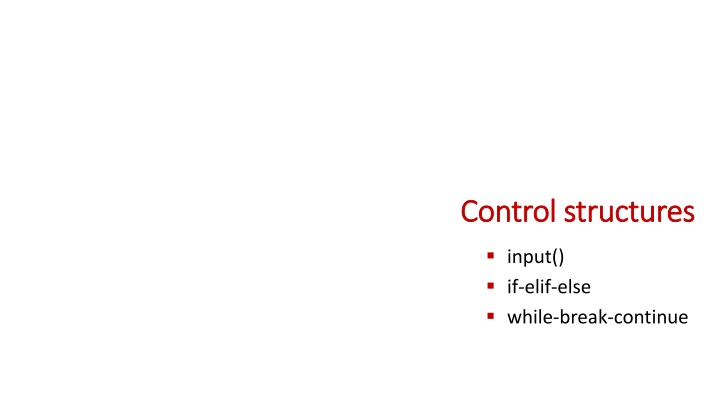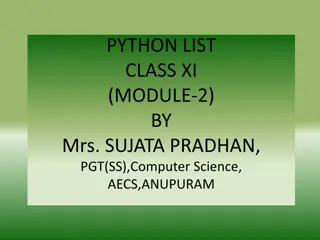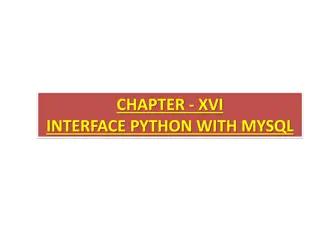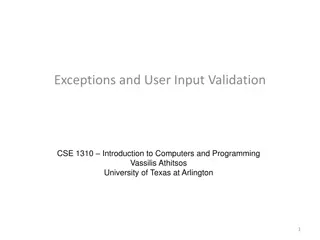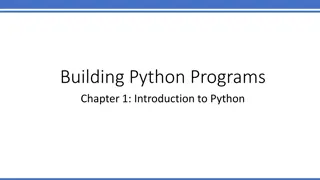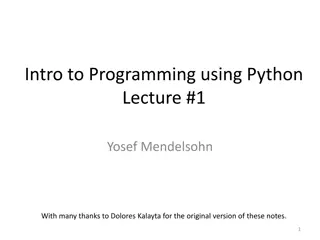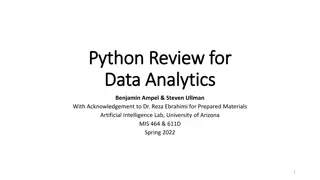Python Programming Basics: Control Structures & Input Handling
Brief introduction to control structures in Python, covering if-elif-else statements, while loops with break and continue statements, and the usage of the input() function for user input handling. Explore branching concepts, basic if statements, and the pass statement for future code placeholders. Understand nested if statements and practice code examples for better comprehension of Python programming fundamentals.
Download Presentation

Please find below an Image/Link to download the presentation.
The content on the website is provided AS IS for your information and personal use only. It may not be sold, licensed, or shared on other websites without obtaining consent from the author.If you encounter any issues during the download, it is possible that the publisher has removed the file from their server.
You are allowed to download the files provided on this website for personal or commercial use, subject to the condition that they are used lawfully. All files are the property of their respective owners.
The content on the website is provided AS IS for your information and personal use only. It may not be sold, licensed, or shared on other websites without obtaining consent from the author.
E N D
Presentation Transcript
Control structures Control structures input() if-elif-else while-break-continue
input input The builtin function input(message)prints message, and waits for the user provides a line of input and presses return. The line of input is returned as a str If you e.g. expect input to be an int, then remember to convert the input using int() name-age.py name = input('Name: ') age = int(input('Age: ')) print(name, 'is', age, 'years old') Python shell > Name: Donald Duck > Age: 84 | Donald Duck is 84 years old
Branching Branching do either this or that ? do either this or that ? Code before make decision ? boolean expression True False do this do that Code after
Basic if Basic if- -else else if boolean expression: code code code else: code code code identical indentation if-else.py if x % 2 == 0: print('even') else: print('odd') identical indentation Identical indentation for a sequence of lines = the same spaces/tabs should precede code
pass pass pass is a Python statement doing nothing. Can be used where a statement is required but you want to skip (e.g. code will be writen later) Example (bad example, since else could just be omitted): if-else.py if x % 2 == 0: print('even') else: pass
if.py if x == 0: print('zero') if if- -elif elif- -else else if condition: elif condition: # zero or more elfi else if code else: # optional code if-else.py if x % 2 == 0: print('even') else: print('odd') code elif.py if x < 0: print('negative') elif x == 0: print('zero') elif x == 1: print('one') else: print('>= 2') if (condition) { code } else if (condition) { code } else { code } Java, C, C++ syntax Other languages using indentation for blocking: ABC (1976), occam (1983), Miranda (1985)
Questions Questions What value is printed? What value is printed? a) 1 b) 2 c) 3 d) 4 e) 5 f) Don t know x = 1 if x == 2: x = x + 1 else: x = x + 1 x = x + 1 x = x + 1 print(x)
Nested if Nested if- -statements statements nested-if.py if x < 0: print('negative') elif x % 2 == 0: if x == 0: print('zero') elif x == 2: print('even prime number') else: print('even composite number') else: if x == 1: print('one') else: print('some odd number')
Common Common mistake mistake if-elif.py x = int(input()) if x == 0: print('zero') elif x % 2 == 0: print('even') Python shell > 0 | zero if-if.py x = int(input()) if x == 0: print('zero') if x % 2 == 0: print('even') Python shell > 0 | zero | even
if if- -else else expressions expressions A very common computation is if test: think of this as the common case and the exceptional case x = true-expression else: x = false-expression In Python there is a shorthand for this: x = true-expression if test else false-expression (see What s New in Python 2.5 - PEP 308: Conditional Expressions) In C, C++ and Java the equivalent notation is (note the different order) x = test ? true-expression : false-expression
Repeat until done Repeat until done Code before True do it once more repeat ? boolean expression False Code after
while while- -statement statement The function randint(a, b) from module random returns a random integer from {a, a + 1,..., b 1, b} while condition: code ... break # jump to code after while loop ... continue# jump to condition at the ... # beginning of while loop random-pair.py from random import randint while True: x = randint(1, 10) y = randint(1, 10) if abs(x - y) >= 2: break print('too close', x, y) print(x, y) count.py x = 1 while x <= 5: print(x, end=' ') x = x + 1 print('and', x) Python shell | too close 4 4 | too close 10 9 | 8 5 while (condition) { code } Java, C, C++ syntax Python shell | 1 2 3 4 5 and 6
An exercise asks to simplify the code ? using binary search using binary search Computing Computing int-sqrt.py x = 20 low = 0 high = x + 1 while True: # low <= sqrt(x) < high if low + 1 == high: break mid = (high + low) // 2 if mid * mid <= x: low = mid continue high = mid print(low) # low = floor(sqrt(x)) Integer division high+low 2 mid ? mid2 ? ? ? mid low high ? ? + 1 0
Division using the Newton Division using the Newton- -Raphson method Raphson method division.py Goal: Compute 1 / n only using +, -, and * x = 1 / n f(x) = n 1 / x = 0 Problem reduces to finding root of f Newton-Raphson: x := x-f(x)/f (x) = x-(n-1/x)/(1/x2) = (2-n x) x since f (x) = 1 / x2 for f(x) = n 1 / x n = 0.75 # n in [0.5, 1.0] x = 1.0 last = 0.0 while last < x: print(x) last = x x = (2 - n * x) * x print('Apx of 1.0 /', n, '=', x) print('Python 1.0 /', n, '=', 1.0 / n) Python shell | 1.0 | 1.25 | 1.328125 | 1.33331298828125 | 1.3333333330228925 | 1.3333333333333333 | Apx of 1.0 / 0.75 = 1.3333333333333333 | Python 1.0 / 0.75 = 1.3333333333333333 f(x) x f(x) / f (x) root next approximation (x, f(x)) current approximation en.wikipedia.org/wiki/Newton s_method
